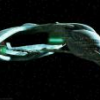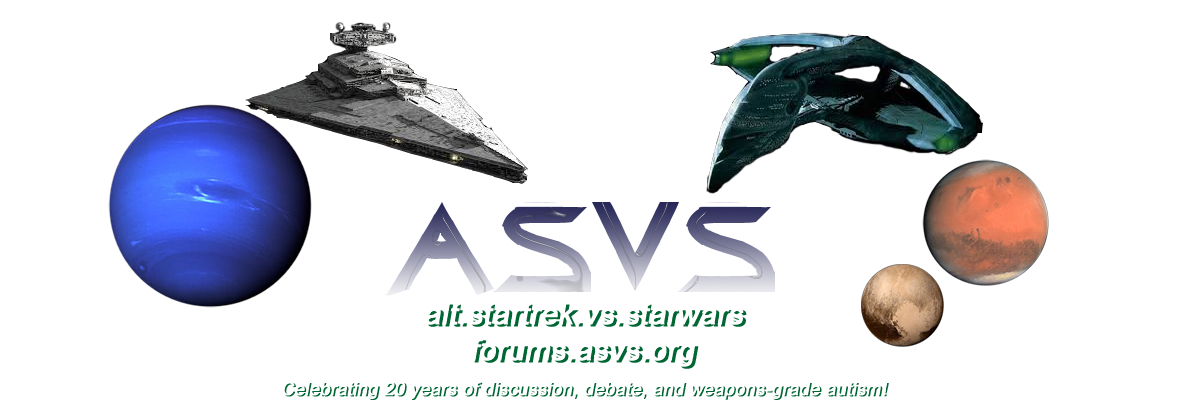-
Content Count
571 -
Joined
-
Last visited
-
Days Won
9
Vince last won the day on June 28 2014
Vince had the most liked content!
Community Reputation
520 ExcellentAbout Vince
-
Rank
Senior Member
Profile Information
-
Gender
Not Telling
-
"Years of orbital bombardment and beam-weapon assaults". The Clone Wars lasted some years, so I'm assuming we're looking at the cumulative effects of many bloody ground wars and tactical bombardments from orbit. Later we have 700-800 meter wide "bomb craters". So probably nuclear scale weapons in excess of 1 megaton yield were being used at some point.
-
Interesting, although it's hardly a lower limit. Considering the world is artificial is it not possible that there is some kind of artificial gravity?
-
An AT RT is relatively small, fast and nimble, whereas the AT ST is as wide as a truck, taller than a house and relatively lumbering; I think it is safe to assume that the AT ST's armour protects it from common small-arms fire. Then to beyond reasonable doubt Blaster bolts can result in explosive fireballs and fragment wall or rock; these feats represent impressive firepower regardless of whether they are secondary effects to flash vaporization, or the primary effects of "explosive bolts". That phasers can can explosively blast or disintegrate rock? I agree with those points. And I didn't consider it a change of subject. The discussion was about whether a hand-held phaser could destroy an AT ST, and the precise firepower and mechanics of phasers is only one side of that discussion. I simply meant to point out that blasters aren't too far behind phasers on the wall blasting side of things, so that when it comes to explosive fragmentation these weapons are of similar magnitude, which by extension also implies that blaster resilient armours may be resilient to phasers. But phasers have the option of disintegration (or "clean vaporization" as you call it) on the same maximum setting, which would be an OCP for armour in star wars. Indeed. Quite a few pots and pans there.
-
I agree with Tyralak, the Breen rifle would probably blast an AT ST easily, but not a hand-held phaser. AT ST's have been proven to be relatively susceptible to kinetic impacts like falling logs, but this tells us nothing about their resistance to DEW's like blasters or phasers. Iit can however be inferred that the AT ST is in-fact highly resilient to blaster fire, and phasers are not THAT much more powerful than blasters, when both weapons are set to maximum setting. Blasters, like phasers, would be anti-vehicular weaponry in the real world when on the highest settings, probably capable of taking out humvees and the like. So are blasters. It is pretty decisively demonstrated that blaster pistols and blaster carbines can rival modern day 40mm autocannons for per shot destructive firepower, when set to maximum setting. But to be fair if Han's shoot-out with the stormtroopers on Tatooine is anything to go by, then we could say that blasters are limited to perhaps only a half dozen shots or so when set to such high power, which is a limitation, but even light vehicles like AT ST's are virtually impervious to small-arms blaster fire regardless. So yes, phasers can destroy a larger volume of material by a marginal degree (although the method is more commonly disintegration) but the difference isn't great enough to start asserting that the standard hand-held phaser in star trek is an anti-vehicle weapon in star wars. especially when said vehicles handle blaster fire with such ease. Not unless you start arguing that AT ST's have little resilience to phaser-style magic disintegration, but such an assertion would be rather arbitrary and difficult to prove, since phasers (like most weapons) quite clearly vary in performance depending on the type of metal they are firing upon in star trek - and vehicles in star wars never face disintegration style weapons in the canon. Dynamite-like effects: There is that scene with the armoured blast door. Phasers disintegrated a wide, but very thin layer of lesser metal across the surface, but the metal beneath was impervious. That is one of the more impressive metal disintegrations that I'm aware of.
-
2K, do you still stand by all of your conclusions and assertions from STvSW? Would you still consider a handheld phaser capable of destroying an AT ST?
-
From the way they behave they must be "magical space lasers" really, although the effects are usually relatively mundane (explosions, heating). Although I'd be interested to see your ideas.
-
DSG, if and when I get around to fleshing out the acceleration pages I assure you they will contain neither the Falcon take off scene nor the broken TCW video .
-
I wonder about the canonicity of that story arc, since it was never released? And I'm skeptical about assuming phaser style disintegration from the unfinished cartoon graphic. If such a crystal is used in the Death Star then it doesn't change all that much. My shield analysis on YouTube is still valid, since it was based on debris which we see moving at measurable velocities on screen. The energy needed to accelerate the planets mass to such incredible velocities still has to exist, and if it is created by the crystal, then the Death Star still had to handle such magnitudes of power during the firing sequence of it's superlaser; it still sets an incredibly high benchmark for the power handling capabilities of starships in Star Wars. http://www.galacticempirewars.com/death-star-firepower
-
Sorry, I never saw this till now. That single property would be explainable, yes, but when you take all blaster characteristics into account they become unexplainable. But yes, in principle, I agree. They must be some kind of containment, otherwise how would they pass through atmosphere and water without any interaction. But I'm reluctant to start calling them plasma, or laser, etc.
-
Well, give the references, the most consistent trend would seem to be "metal? Steel. Metal? Steel. Metal? Steel. Steel? Metal".
-

Star Wars without massive power generation. Would that make sense?
Vince replied to Vince's topic in The Mental Gymnasium
I had considered something similar before. since the fuel requirements for these things are so astronomically high, I had pondered some kind of power source that somehow derives the energy from outside the ship. Perhaps another dimension, or another point in the galaxy such as a black hole through like, a wormhole or something. I think the former is much more feasible and likely. I'm not sure a "hyperspace tap" would work because if so much power could be drawn from hyperspace then that would mean that hyperspace is a energy dimension. I don't think you could fly through an energy dimension without getting destroyed utterly instantly. And hyperspace might not even be another dimension, it might just be normal speed perceived at FTL speed. It's worth considering that such a theory doesn't technically make ships less powerful, though. Their not using fuel to generate all the power they need to move or blow up planets, but would be deriving the needed power from outside the ship, probably outside the universe, somewhere in the multiverse. If a star destroyer didn't have to carry fuel to perform multi-thousand G accelerations and acheive relativistic speeds then it would only need about a tenth of the power to move. You would probably need conventional fusion or annihilation reactors to maintain the interdimensional power source, though. It would also explain why ships are not so nearly as volatile as the ones in Star Trek.


